Molybdenite Re-Os Isotopic Ages of Two Late Mesozoic Giant Mo Deposits in the Eastern Qinling Orogenic Belt, Central China
Abstract
1. Introduction
2. Geological Background and Petrography
3. Analytical Technique and Results
4. Discussion
4.1. Mo Mineralization Stages
4.2. Implications for the Mineralization and Geodynamics
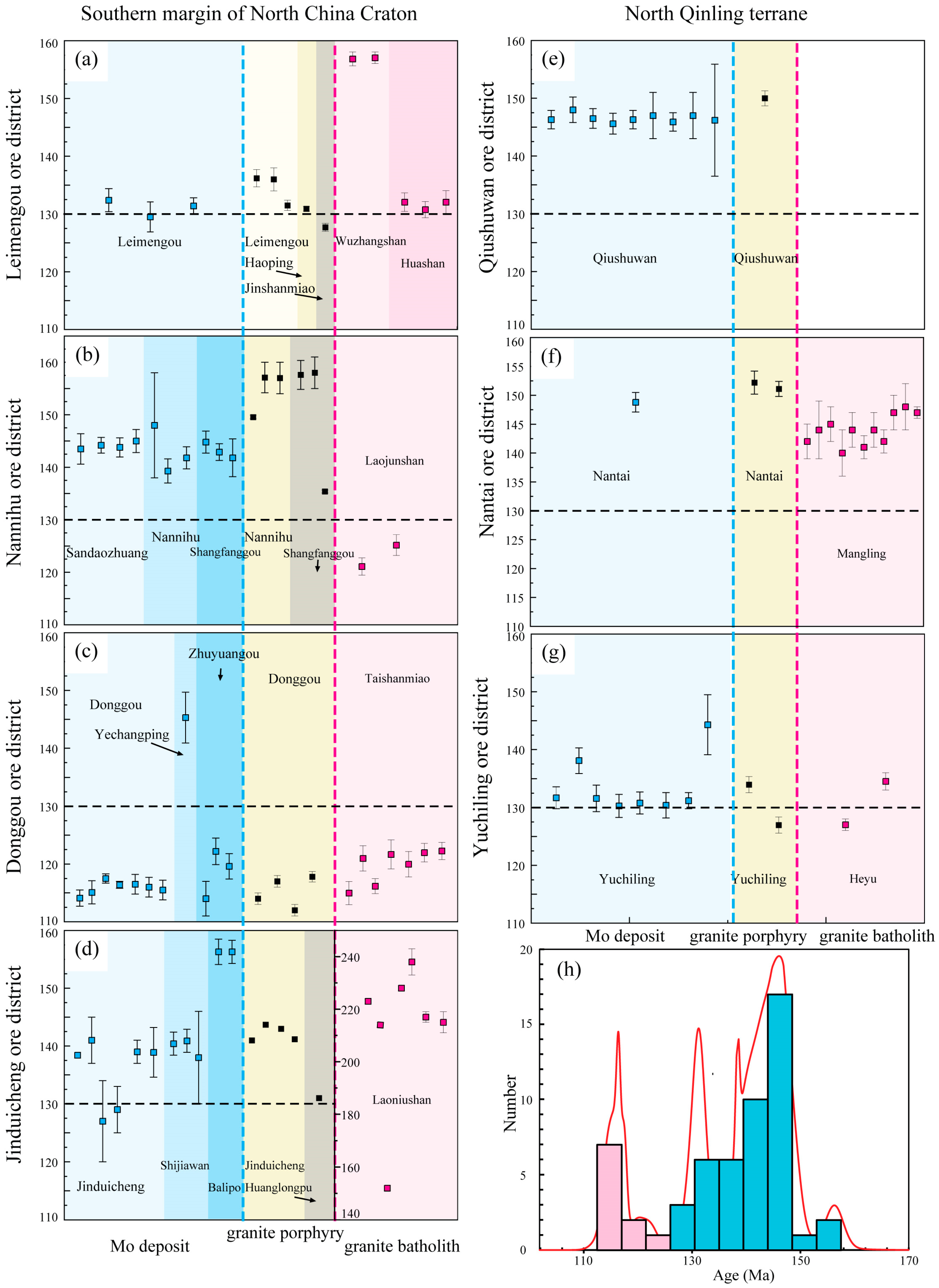
5. Conclusions
Author Contributions
Funding
Data Availability Statement
Acknowledgments
Conflicts of Interest
References
- Audétat, A. Source and evolution of molybdenum in the porphyry Mo (-Nb) deposit at Cave Peak, Texas. J. Petrol. 2010, 51, 1739–1760. [Google Scholar] [CrossRef]
- Bao, Z.W.; Wang, Y.C.; Zhao, T.P.; Liu, C.J.; Gao, X.Y. Petrogenesis of the Mesozoic granites and Mo mineralization of the Luanchuan ore field in the East Qinling Mo mineralization belt, Central China. Ore Geol. Rev. 2014, 57, 132–153. [Google Scholar] [CrossRef]
- Hou, Z.Q.; Gao, Y.F.; Qü, X.M.; Rui, Z.Y.; Mo, X.X. Origin of adakitic intrusives generated during mid-Miocene east-west extension in southern Tibet. Earth Planet. Sci. Lett. 2004, 220, 139–155. [Google Scholar] [CrossRef]
- Yang, L.; Chen, F.; Liu, B.-X.; Hu, Z.-P.; Qi, Y.; Wu, J.-D.; He, J.-F.; Siebel, W. Geochemistry and Sr-Nd-Pb-Hf isotopic composition of the Donggou Mo-bearing granite porphyry, Qinling orogenic belt, central China. Int. Geol. Rev. 2013, 55, 1261–1279. [Google Scholar] [CrossRef]
- Mercer, C.N.; Hofstra, A.H.; Todorov, T.I.; Roberge, J.; Burgisser, A.; Adams, D.T.; Cosca, M. Pre-eruptive conditions of the hideaway park topaz rhyolite: Insights into metal source and evolution of magma parental to the Henderson porphyry molybdenum deposit, Colorado. J. Petrol. 2015, 56, 645–679. [Google Scholar] [CrossRef]
- Sun, W.D.; Li, C.Y.; Ling, M.X.; Ding, X.; Yang, X.Y.; Liang, H.Y.; Zhang, H.; Fan, W.M. The geochemical behavior of molybdenum and mineralization. Acta Petrol. Sin. 2015, 31, 1807–1817, (In Chinese with English Abstract). [Google Scholar]
- Mao, J.W.; Pirajno, F.; Xiang, J.F.; Gao, J.J.; Ye, H.S.; Li, Y.F.; Guo, B.J. Mesozoic molybdenum deposits in the East Qinling-Dabie orogenic belt: Characteristics and tectonic settings. Ore Geol. Rev. 2011, 43, 264–293. [Google Scholar] [CrossRef]
- Wang, X.X.; Wang, T.; Zhang, C.L. Neoproterozoic, Paleozoic, and Mesozoic granitoid magmatism in the Qinling Orogen, China: Constraints on orogenic process. J. Asian Earth Sci. 2013, 72, 129–151. [Google Scholar] [CrossRef]
- Li, Z.K.; Bi, S.J.; Li, J.W.; Zhang, W.; Cooke, D.R.; Selby, D. Distal Pb-Zn-Ag veins associated with the world-class Donggou porphyry Mo deposit, southern North China craton. Ore Geol. Rev. 2017, 82, 232–251. [Google Scholar] [CrossRef]
- Meng, Q.R.; Zhang, G.W. Geologic framework and tectonic evolution of the Qinling orogen, Central China. Tectonophysics 2000, 323, 183–196. [Google Scholar] [CrossRef]
- Wilde, S.A.; Zhao, G.C.; Sun, M. Development of the North China Craton during the late Archaean and its final amalgamation at 1.8 Ga: Some speculations on its position within a global Palaeoproterozoic supercontinent. Gondwana Res. 2002, 5, 85–94. [Google Scholar] [CrossRef]
- He, Y.H.; Zhao, G.C.; Sun, M.; Xia, X.P. SHRIMP and LA-ICP-MS zircon geochronology of the Xiong’er volcanic rocks: Implications for the Paleo-Mesoproterozoic evolution of the southern margin of the North China Craton. Precambrian Res. 2009, 168, 213–222. [Google Scholar] [CrossRef]
- He, J.; Qi, Y.; Fan, X.; Chen, F. Petrogenesis of the Taishanmiao A-type granite in the eastern Qinling orogenic belt: Implications for tectonic transition and mineralization in the Late Cretaceous. J. Geol. 2021, 129, 97–114. [Google Scholar] [CrossRef]
- He, J.; Xu, X.C.; Fu, Z.Y.; An, Y.H.; Chen, T.H.; Xie, Q.Q.; Chen, F. Decoupling of Sr-Nd isotopic composition induced by potassic alteration in the Shapinggou porphyry Mo deposit of the Qinling-Dabie orogenic belt, China. Minerals 2021, 11, 910. [Google Scholar] [CrossRef]
- Li, N.; Chen, Y.J.; Zhang, H. Geological character of the granite porphyry molybdenum belt and orogenic tectonic setting. Earth Sci. Front. 2007, 14, 186–198, (In Chinese with English Abstract). [Google Scholar]
- Zhang, Y.S.; Siebel, W.; He, S.; Wang, Y.; Chen, F.K. Origin and genesis of Late Jurassic to Early Cretaceous granites of the North Qinling Terrane, China. Lithos 2019, 336–337, 242–257. [Google Scholar] [CrossRef]
- Mao, J.W.; Xie, G.Q.; Bierlein, F.; Qü, W.J.; Du, A.D.; Ye, H.S.; Pirajno, F.; Li, H.M.; Guo, B.J.; Li, Y.F.; et al. Tectonic implications from Re-Os dating of Mesozoic molybdenum deposits in the East Qinling-Dabie orogenic belt. Geochim. Cosmochim. Acta 2008, 72, 4607–4626. [Google Scholar] [CrossRef]
- Li, N.; Chen, Y.J.; Pirajno, F.; Ni, Z.Y. Timing of the Yuchiling giant porphyry Mo system, and implications for ore genesis. Miner. Depos. 2013, 48, 505–524. [Google Scholar] [CrossRef]
- Gao, X.Y.; Zhao, T.P. Late Mesozoic magmatism and tectonic evolution in the Southern margin of the North China Craton. Sci. China (Ser. D Earth Sci.) 2017, 60, 1959–1975. [Google Scholar] [CrossRef]
- Yang, L. Geochemistry and metallogenic geodynamic setting of the Late Mesozoic Mo deposits in the eastern Qinling Mountains, central China. Doctoral Dissertation, University of Chinese Academy of Sciences, Beijing, China, 2013; pp. 1–125, (In Chinese with English Abstract). [Google Scholar]
- Gao, X.Y.; Zhao, T.P.; Bao, Z.W.; Yang, A.Y. Petrogenesis of the early Cretaceous intermediate and felsic intrusions at the southern margin of the North China Craton: Implications for crust-mantle interaction. Lithos 2014, 206–207, 65–78. [Google Scholar] [CrossRef]
- Du, A.D.; Wu, S.Q.; Sun, D.Z.; Wang, S.; Qu, W.; Markey, R.; Stain, H.; Morgan, J.; Malinovskiy, D. Preparation and Certification of Re-Os Dating Reference Materials: Molybdenite HLP and JDC. Geostand. Geoanal. Res. 2004, 28, 41–52. [Google Scholar] [CrossRef]
- Smoliar, M.I.; Walker, R.J.; Morgan, J.W. Re-Os ages of group IIA, IIIA, IVA, and IVB iron meteorites. Science 1996, 271, 1099–1102. [Google Scholar] [CrossRef]
- Ludwig, K.R. Isoplot/Ex, version 2.06; A Geochronological Toolkit for Microsoft Excel; Geochronology Center: Berkeley, CA, USA, 1999; Special Publication 1a. [Google Scholar]
- Markey, R.; Stein, H.; Morgan, J. Highly precise Re–Os dating for molybdenite using alkaline fusion and NTIMS. Talanta 1998, 45, 935–946. [Google Scholar] [CrossRef] [PubMed]
- Raith, J.G.; Stein, H.J. Re-Os dating and sulfur isotope composition of molybdenite from tungsten deposits in western Namaqualand, South Africa: Implications for ore genesis and the timing of metamorphism. Miner. Depos. 2000, 35, 741–753. [Google Scholar]
- Stein, H.J.; Markey, R.J.; Morgan, J.W.; Du, A.D.; Sun, Y. Highly precise and accurate Re-Os ages for molybdenite from the East Qinling molybdenum belt, Shaanxi Province, China. Econ. Geol. 1997, 92, 827–835. [Google Scholar] [CrossRef]
- Bo, Z.Y. Cretaceous Granitic Magmatism and Molybdenum Mineralization in the Jinduicheng Area of the East Qinling. Master’s Thesis, China University of Geosciences, Beijing, China, 2023; pp. 1–60, (In Chinese with English Abstract). [Google Scholar]
- Ye, H.S. The Mesozoic Tectonic Evolution and Pb-Zn-Ag Metallogeny in the South Margin of North China Craton. Doctoral Dissertation, Chinese Academy of Geological Sciences, Beijing, China, 2006; pp. 1–217, (In Chinese with English Abstract). [Google Scholar]
- Gao, Y.; Ye, H.S.; Mao, J.W.; Li, Y.F. Geology, geochemistry and genesis of the Qianfanling quartz-vein Mo deposit in Songxian County, western Henan province, China. Ore Geol. Rev. 2013, 55, 13–28. [Google Scholar] [CrossRef]
- Li, H.M.; Ye, H.S.; Mao, J.W.; Wang, D.H.; Chen, Y.C.; Qu, W.J.; Du, A.D. Re-Os dating of molybdenites from the Dahu Au(Mo) deposit in the Xiaoqinling gold ore district and its geological significance. Miner. Depos. 2007, 26, 417–424, (In Chinese with English Abstract). [Google Scholar]
- Li, N.; Chen, Y.J.; Ni, Z.H.; Hu, H.Z. Characteristics of ore forming fluids of the Yuchiling porphyry Mo deposit, Songxian County, Henan province, and its geological significance. Acta Petrol. Sin. 2009, 25, 2509–2522, (In Chinese with English Abstract). [Google Scholar]
- Bao, Z.W.; Zeng, Q.S.; Zhao, T.P.; Yuan, Z.L. Geochemistry and petrogenesis of the ore-related Nannihu and Shangfanggou granite porphyries from east Qinling belt and their constraints on the molybdenum mineralization. Acta Petrol. Sin. 2009, 25, 2523–2536, (In Chinese with English Abstract). [Google Scholar]
- Zhao, H.X.; Jiang, S.Y.; Frimmel, H.E.; Dai, B.Z.; Ma, L. Geochemistry, geochronology and Sr–Nd–Hf isotopes of two Mesozoic granitoids in the Xiaoqinling gold district: Implication for large-scale lithospheric thinning in the North China Craton. Chem. Geol. 2012, 294–295, 173–189. [Google Scholar] [CrossRef]
- Bao, Z.W.; Sun, W.D.; Zartman, R.E.; Yao, J.M.; Gao, X.Y. Recycling of subducted upper continental crust: Constraints on the extensive molybdenum ore mineralization in the Qinling-Dabie orogen. Ore Geol. Rev. 2017, 81, 451–465. [Google Scholar] [CrossRef]
- Yu, J.; Li, N.; Qi, N.; Xu, C.; Huang, P.-C.; Hand, M.; Morrissey, L.J.; Payne, J.L.; Chen, Y.-J. Geochemical, geochronological and isotopic studies of the Taishanmiao batholith and the Zhuyuangou Mo deposit it hosted, Qinling, China. Ore Geol. Rev. 2022, 142, 104711. [Google Scholar] [CrossRef]
- Huang, F. A Study on the Genesis of the Giant Donggou Porphyry Mo Deposit, Henan Province. Master’s Thesis, China University of Geosciences (Beijing), Beijing, China, 2009; pp. 1–127, (In Chinese with English Abstract). [Google Scholar]
- Li, N. Porphyry Mo deposits: New sub-types and ore-controlling factors. Bull. Mineral. Petrol. Geochem. 2022, 41, 113–126, (In Chinese with English Abstract). [Google Scholar]
- Chen, Y.J.; Li, N.; Deng, X.H.; Yang, Y.F.; Pirajno, F. Molybdenum Mineralization in Qinling Orogen; China Science Publishing & Media Ltd.: Beijing, China, 2020. [Google Scholar]
- Dai, B.Z.; Jiang, S.Y.; Wang, X.L. Petrogenesis of the granitic porphyry related to the giant molybdenum deposit in Donggou, Henan province, China: Constraints from petrogeochemistry, zircon U-Pb chronology and Sr-Nd-Hf isotopes. Acta Petrol. Sin. 2009, 11, 2889–2901, (In Chinese with English Abstract). [Google Scholar]
- Hu, X.K.; Tang, L.; Zhang, S.T.; Santash, M.; Sun, L.; Spencer, C.J.; Jeon, H.; Zhao, Y.; Huang, D.F. Geochemistry, zircon U-Pb geochronology and Hf-O isotopes of the Late Mesozoic granitoids from the Xiong’ershan area, East Qinling Orogen, China: Implications for petrogenesis and molybdenum metallogeny. Ore Geol. Rev. 2020, 124, 103653. [Google Scholar] [CrossRef]
- Mao, J.W.; Xie, G.Q.; Pirajno, F.; Ye, H.S.; Wang, Y.B.; Li, Y.F.; Xiang, J.F.; Zhao, H.J. Late Jurassic-Early Cretaceous granitoid magmatism in East Qinling, central eastern China: SHRIMP zircon U-Pb ages and tectonic implications. Aust. J. Earth Sci. 2010, 57, 51–78. [Google Scholar] [CrossRef]
- Tang, H.Y.; Gao, L.T.; Yu, C.M.; Zheng, J.P. Melting of the Neoproterozoic Yangtze crustal remnants beneath the North Qinling Terrane induced by the Paleo-Pacific plate subduction: Evidence from the Early Cretaceous Laojunshan granitoids. J. Asian Earth Sci. 2021, 216, 104826. [Google Scholar] [CrossRef]
- Wang, Y.H.; Liu, J.J.; Zhang, F.F.; Zhang, Z.Y.; Zhang, W.; Bo, Z.Y. Late Mesozoic post-orogenic granitoids and its metallogenic implications: Constraints from Nantai porphyry Mo deposit, Northern Qinling, China. Ore Geol. Rev. 2021, 139, 104480. [Google Scholar] [CrossRef]
- Huang, F.; Luo, Z.H.; Lu, X.X.; Chen, B.H.; Yang, Z.F. Geological characteristics, metallogenic epoch and geological significance of the Zhuyuangou molybdenum deposit in Ruyang area, Henan, China. Geol. Bull. China 2010, 29, 1704–1711, (In Chinese with English Abstract). [Google Scholar]
- He, J.; Qi, Z.Q.; Hu, A.M.; Wang, Z.Y.; Li, J.S.; Chen, F. Compositional diversity of late Mesozoic granites rooting from the subducted crust in the Qinling-Dabie orogenic belt. Lithos 2024, 488–489, 107785. [Google Scholar] [CrossRef]
- Li, Y.J.; Zhu, G.; Su, N.; Xiao, S.Y.; Zhang, S.; Liu, C.; Xie, C.L.; Yin, H.; Wu, X.D. The Xiaoqinling metamorphic core complex: A record of Early Cretaceous backarc extension along the southern part of the North China Craton. Geol. Soc. Am. 2020, 132, 617–637. [Google Scholar] [CrossRef]
- Li, Y.J.; Zhu, G.; Liu, J.; Sun, K.K.; Gu, C.C.; Dong, M.L.; Yan, J.H.; Li, C.; Xue, F.; Liu, C.; et al. Polyphase deformation history and its structural controls on auriferous quartz vein stockwork in the Xiaoqinling district, southern margin of the North China Craton. Ore Geol. Rev. 2024, 175, 106379. [Google Scholar] [CrossRef]
- He, Y.; Li, S.; Hoefs, J.; Huang, F.; Liu, S.A.; Hou, Z. Post-collisional granitoids from the Dabie orogen: New evidence for partial melting of a thickened continental crust. Geochim. Cosmochim. Acta 2011, 75, 3815–3838. [Google Scholar] [CrossRef]
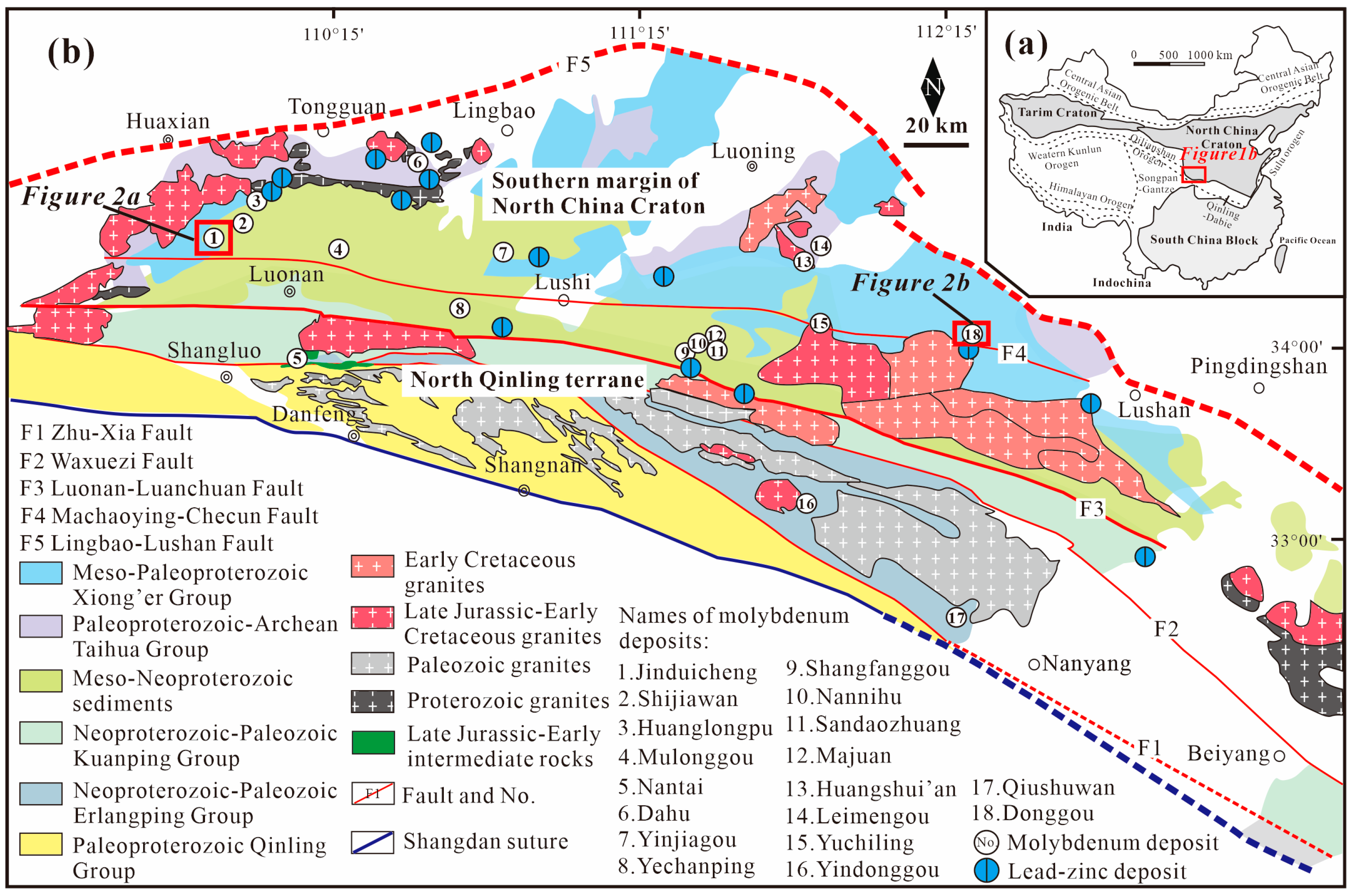
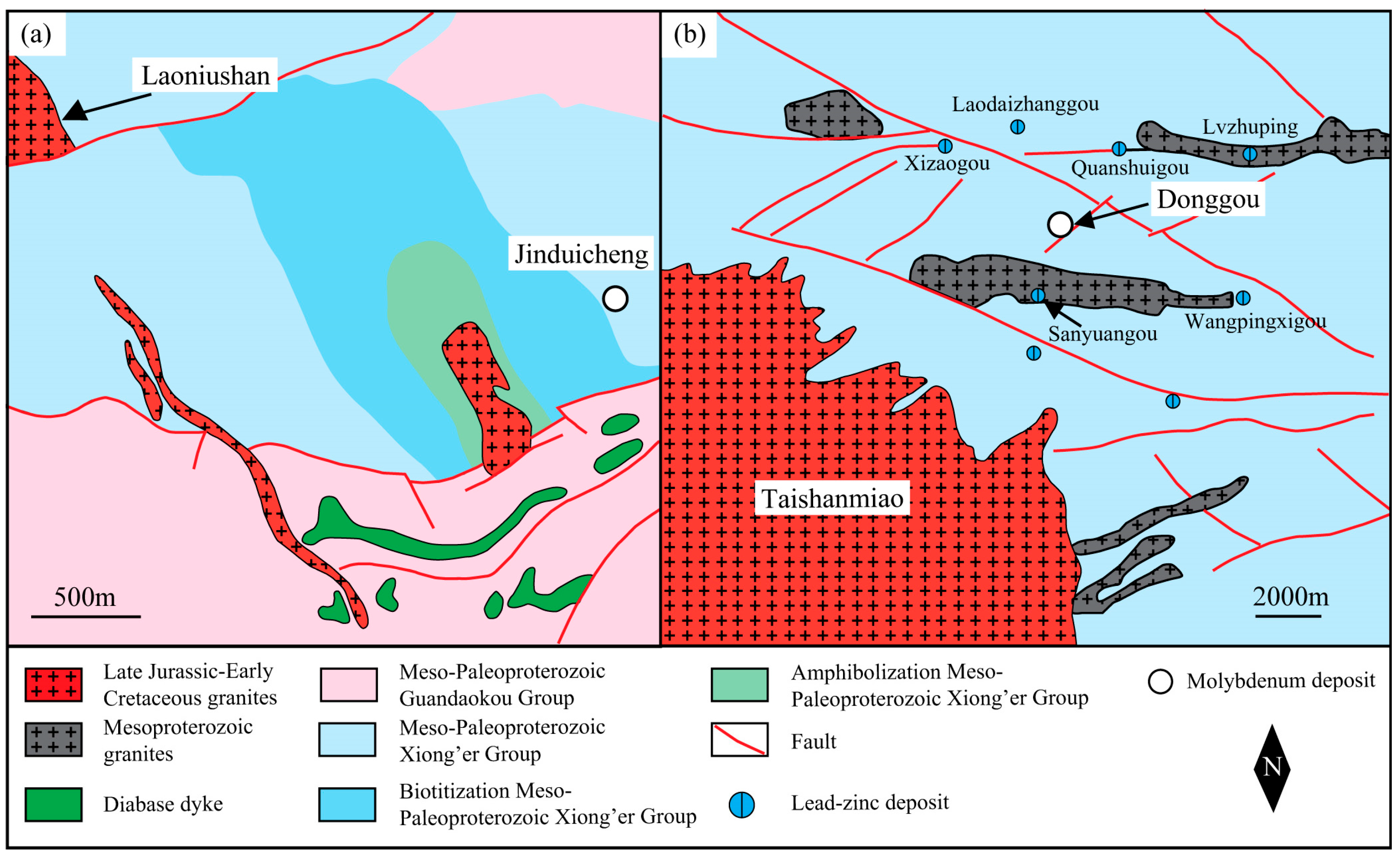

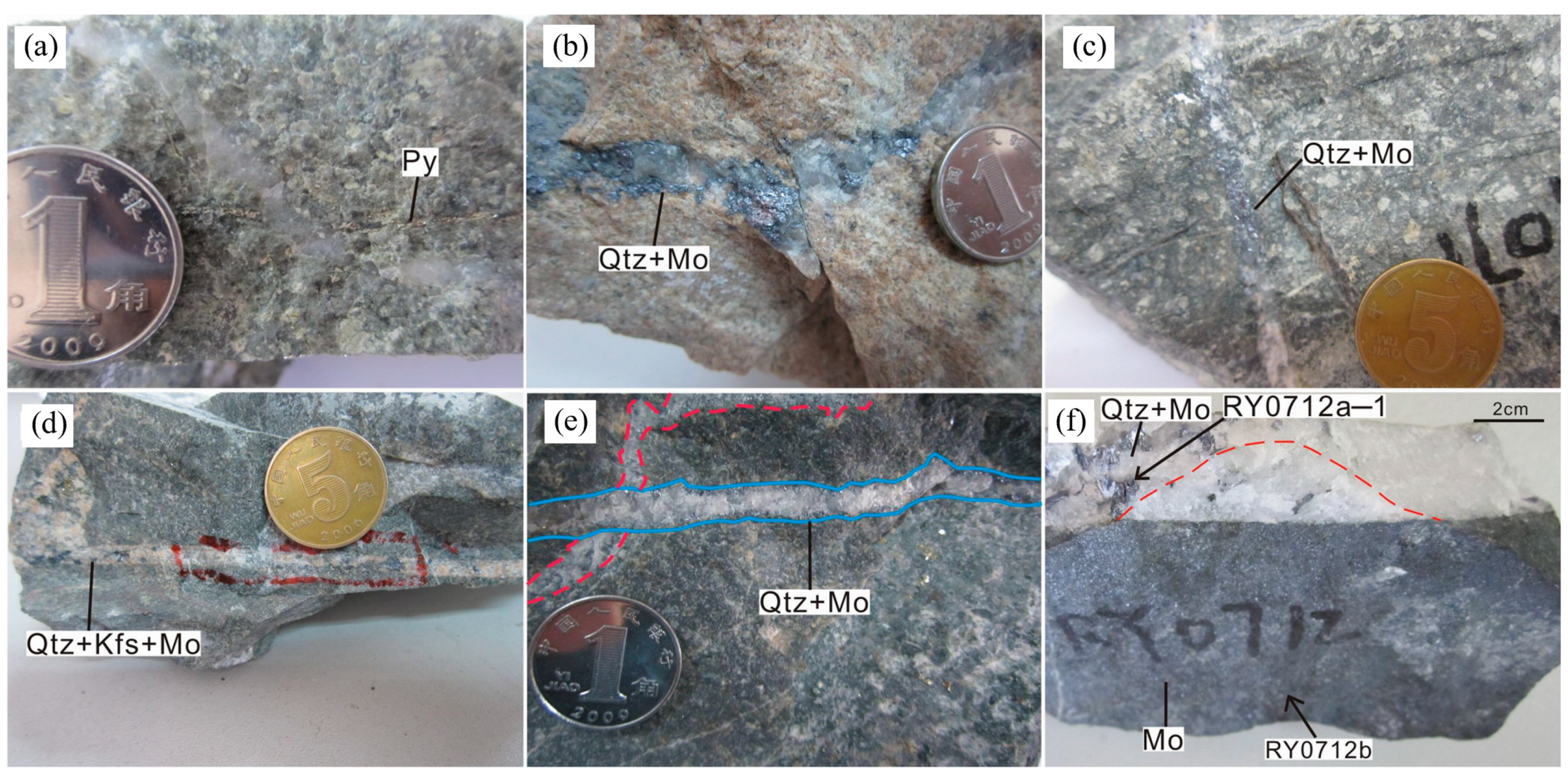
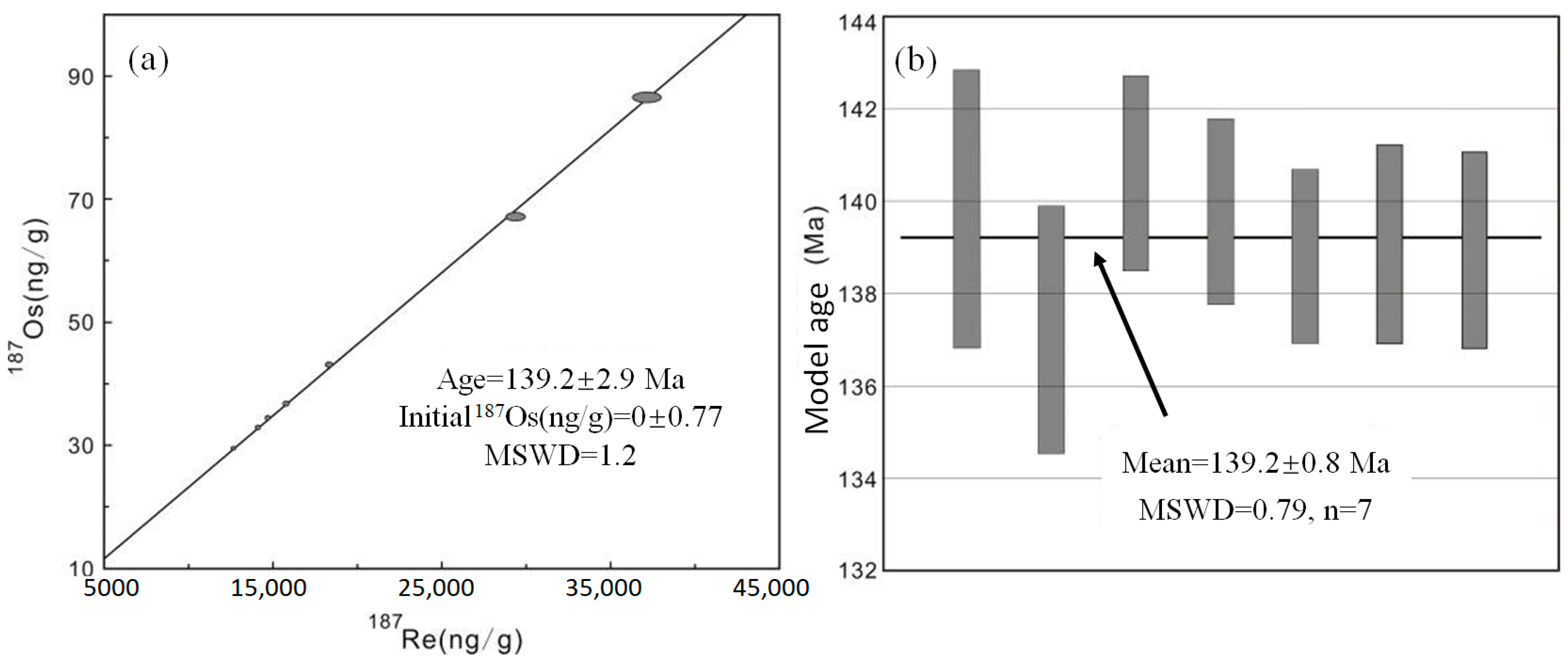
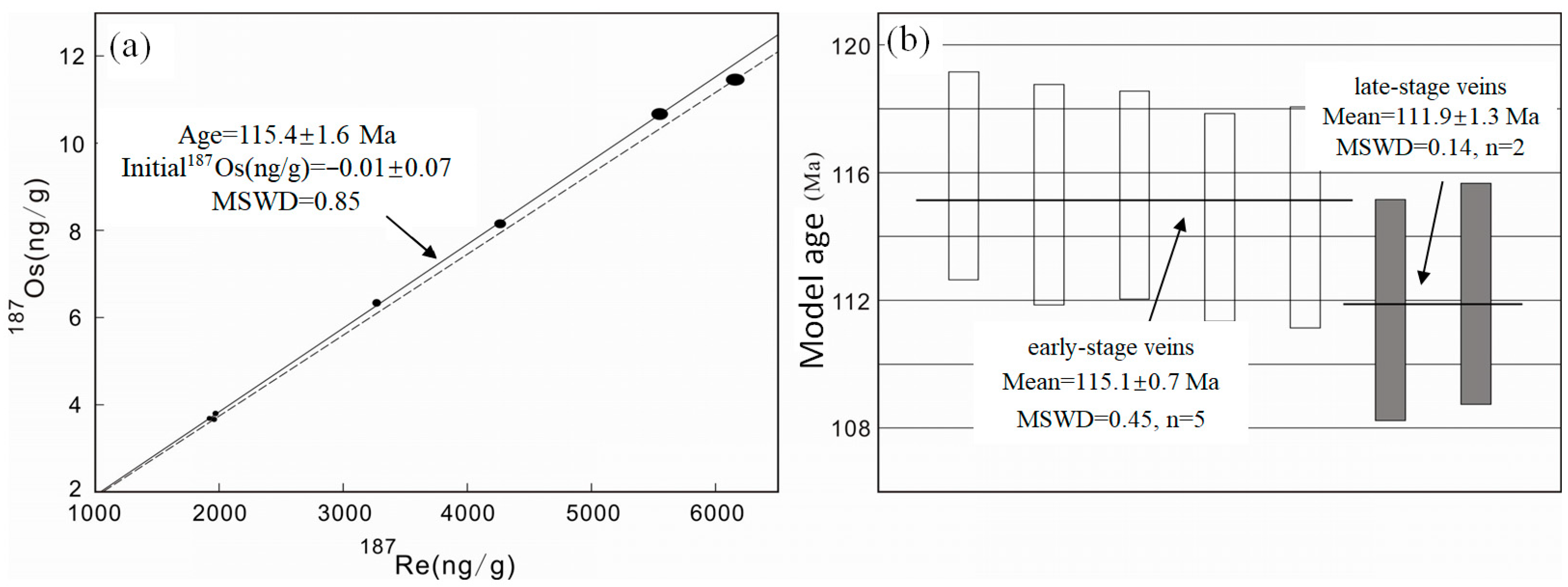
| Sample No. | Weight (mg) | Re ± 2σ (ppm) | 187Re ± 2σ (ppm) | 187Os ± 2σ (ppb) | Model Age ± 2σ (Ma) |
|---|---|---|---|---|---|
| Jinduicheng | |||||
| JDC150-1 | 100.8 | 58.97 ± 1.08 | 37.06 ± 0.68 | 86.43 ± 0.70 | 139.8 ± 3.0 |
| JDC150-2 | 100.4 | 46.67 ± 0.74 | 29.34 ± 0.46 | 67.12 ± 0.55 | 137.2 ± 2.7 |
| JDC150-4 | 100.2 | 29.25 ± 0.29 | 18.38 ± 0.18 | 43.11 ± 0.35 | 140.6 ± 2.1 |
| JDC150-5 | 100.2 | 23.52 ± 0.18 | 14.78 ± 0.11 | 34.45 ± 0.31 | 139.8 ± 2.0 |
| JDC151-4 | 100.8 | 20.29 ± 0.15 | 12.75 ± 0.09 | 29.52 ± 0.24 | 138.8 ± 1.9 |
| JDC151-2 | 50.05 | 25.25 ± 0.25 | 15.87 ± 0.16 | 36.80 ± 0.31 | 139.0 ± 2.2 |
| JDC151-6 | 50.18 | 22.60 ± 0.21 | 14.21 ± 0.13 | 32.91 ± 0.31 | 138.9 ± 2.1 |
| Donggou | |||||
| RY0711-a | 100.5 | 9.79 ± 0.09 | 6.16 ± 0.06 | 11.47 ± 0.10 | 111.7 ± 1.7 |
| RY0712-b | 112.2 | 3.11 ± 0.02 | 1.96 ± 0.01 | 3.66 ± 0.04 | 112.2 ± 1.7 |
| DG0904 | 100.6 | 8.83 ± 0.08 | 5.55 ± 0.05 | 10.66 ± 0.09 | 115.3 ± 1.7 |
| DG0907 | 85.60 | 6.79 ± 0.06 | 4.27 ± 0.04 | 8.16 ± 0.07 | 114.6 ± 1.7 |
| RY0710 | 101.0 | 5.22 ± 0.04 | 3.28 ± 0.03 | 6.33 ± 0.05 | 115.9 ± 1.6 |
| RY0712-a-1 | 77.10 | 3.15 ± 0.03 | 1.98 ± 0.02 | 3.81 ± 0.03 | 115.3 ± 1.6 |
| RY0712-a-2 | 202.6 | 3.07 ± 0.02 | 1.93 ± 0.02 | 3.69 ± 0.03 | 114.6 ± 1.6 |
Disclaimer/Publisher’s Note: The statements, opinions and data contained in all publications are solely those of the individual author(s) and contributor(s) and not of MDPI and/or the editor(s). MDPI and/or the editor(s) disclaim responsibility for any injury to people or property resulting from any ideas, methods, instructions or products referred to in the content. |
© 2025 by the authors. Licensee MDPI, Basel, Switzerland. This article is an open access article distributed under the terms and conditions of the Creative Commons Attribution (CC BY) license (https://creativecommons.org/licenses/by/4.0/).
Share and Cite
Zhang, Y.; Yang, L.; Gui, H.; Wang, D.; He, M.; He, J. Molybdenite Re-Os Isotopic Ages of Two Late Mesozoic Giant Mo Deposits in the Eastern Qinling Orogenic Belt, Central China. Minerals 2025, 15, 800. https://doi.org/10.3390/min15080800
Zhang Y, Yang L, Gui H, Wang D, He M, He J. Molybdenite Re-Os Isotopic Ages of Two Late Mesozoic Giant Mo Deposits in the Eastern Qinling Orogenic Belt, Central China. Minerals. 2025; 15(8):800. https://doi.org/10.3390/min15080800
Chicago/Turabian StyleZhang, Yuanshuo, Li Yang, Herong Gui, Dejin Wang, Mengqiu He, and Jun He. 2025. "Molybdenite Re-Os Isotopic Ages of Two Late Mesozoic Giant Mo Deposits in the Eastern Qinling Orogenic Belt, Central China" Minerals 15, no. 8: 800. https://doi.org/10.3390/min15080800
APA StyleZhang, Y., Yang, L., Gui, H., Wang, D., He, M., & He, J. (2025). Molybdenite Re-Os Isotopic Ages of Two Late Mesozoic Giant Mo Deposits in the Eastern Qinling Orogenic Belt, Central China. Minerals, 15(8), 800. https://doi.org/10.3390/min15080800




